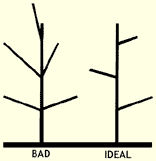Valentine Ice Storm Teaches a Lesson on Trees
Plant trees that stand up to snow and ice
The Valentine ice storm taught a lesson The Bay Gardener hopes public utilities and homeowners remember: Plant the right tree.
About those power outages: Most resulted from falling branches. If only low-growing trees were planted around utility lines, many outages would never occur. Amid today’s jumble of road-hugging trees, the only way short of burying lines to avoid damage from falling branches is to eliminate species with a history of breaking under snow and ice.
The Wrong Trees for Snow and Ice
Most susceptible to breaking under load are species that produce narrow crotch angles and very dense wood containing short fibers. Black locust and pear — the two species most affected — fill those bills. Most good-sized black locusts have lost many of their branches to winter storms. Many Bradford pear trees with tree trunks above six inches suffered tremendous breakage, with many trunks splitting. This is one of the many reasons to avoid Bradford pear trees.
Next most vulnerable are silver and red maples. The damage is most severe in trees with narrow crotch angles. Horticulturists have known for a long time that narrow crotch angles are weak and break under stress. This is why fruit trees are trained to have wide crotch angles that better support the fruit they produce.
Winter storms take advantage of another quality of wood. As temperatures drop below freezing, the tensile strength of wood decreases, making it more brittle. Anyone who has split wood with an ax can attest to the fact that wood splits better when frozen.
Evergreen trees such as pine, spruce, fir, American holly become more susceptible when their lower branches are cut. Leave the lower branches on your evergreens to help support the upper branches when they become loaded with snow and ice.
The Best Tree for Ice and Snow
The tree species that suffered the least damage is the white oak. This oak stands up to winter storms because its wood has very long fibers and its branching habit is generally very wide. Wide crotch angles are strong because their fiber is all exclusively wood fibers, while narrow crotch angles mix bark fibers and wood fibers.
Until they reach maturity, most oak trees are quite resistant to winter damage. Older oaks suffered some damage, especially to brittle dead wood.
Ask Dr. Gouin your questions at [email protected]. All questions will appear in Bay Weekly. Please include your name and address.




